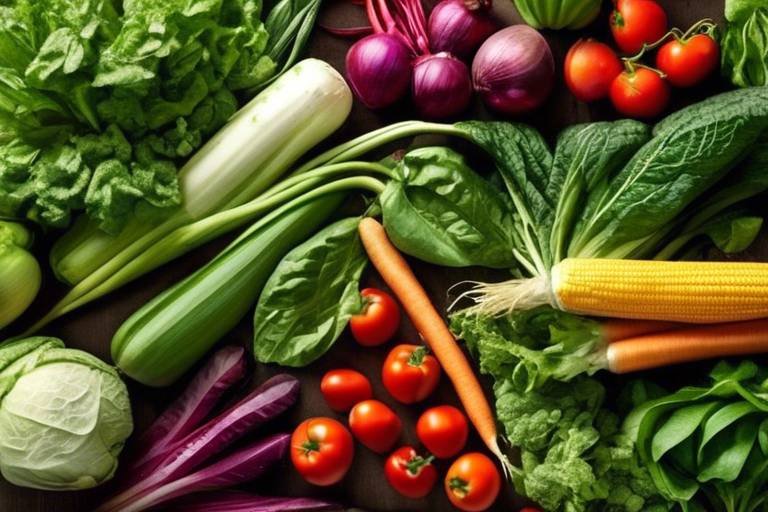How to Reduce Single-Use Plastics in Your Life
Single-use plastics have become a pervasive part of our daily lives, but their convenience comes at a significant cost to the environment. To reduce our reliance on these harmful materials and pave the way for a more sustainable future, it's essential to adopt a conscious approach towards our consumption habits. By making simple yet impactful changes, each individual can play a crucial role in minimizing the use of single-use plastics and contributing to a healthier planet.

Awareness and Mindset Shift
When it comes to reducing single-use plastics in your life, the first step is to cultivate awareness and shift your mindset towards a more sustainable approach. Understanding the impact of single-use plastics on the environment is crucial. Imagine each plastic straw or bag you use as a tiny drop in a vast ocean, contributing to a much larger problem. By acknowledging this, you can start making conscious choices to minimize your plastic footprint.
Consider the journey of a plastic bottle from production to disposal. Reflect on the energy, resources, and pollution involved in its lifecycle. This reflection can spark a mindset shift, motivating you to seek alternatives and reduce your reliance on single-use plastics. It's about recognizing that small changes in your daily habits can lead to significant positive impacts on the environment.
One effective way to raise awareness is by educating yourself about the environmental consequences of single-use plastics. Dive into documentaries, articles, and studies that shed light on the issue. The more you know, the more empowered you become to make informed choices and inspire others to join the movement towards a plastic-free future.

Reusable Alternatives
When it comes to reducing single-use plastics in your daily life, one of the most effective strategies is to embrace reusable alternatives. By making simple switches from disposable items to reusable ones, you can significantly decrease your plastic waste footprint and contribute to a more sustainable future.
Reusable bags are a great starting point for eliminating single-use plastic bags. Investing in sturdy, eco-friendly tote bags or backpacks can make a big difference when shopping for groceries or running errands. These reusable bags not only reduce plastic waste but are also more durable and stylish.
Another essential reusable alternative is a refillable water bottle. By carrying a reusable bottle with you, you can avoid purchasing plastic water bottles and help reduce the staggering amount of plastic waste generated from bottled drinks. Additionally, many establishments now offer water refill stations, making it convenient to stay hydrated on the go.
When it comes to enjoying your favorite beverages, consider switching to reusable straws. Stainless steel, bamboo, or silicone straws are excellent alternatives to single-use plastic straws and can be easily cleaned and reused multiple times. These eco-friendly options are not only better for the environment but also add a touch of style to your drinks.
For storing food and leftovers, opt for reusable containers instead of disposable plastic wrap or bags. Investing in high-quality glass or BPA-free plastic containers allows you to safely store food, reduce waste, and save money in the long run. These versatile containers are perfect for meal prepping, packing lunches, or storing leftovers.
By incorporating these reusable alternatives into your daily routine, you can take a significant step towards minimizing single-use plastics and embracing a more sustainable lifestyle.

Shopping Habits
When it comes to reducing single-use plastics in your life, one of the key areas to focus on is your shopping habits. By being mindful of the products you purchase and the packaging they come in, you can make a significant impact on the amount of plastic waste generated. Opting for items that are not packaged in single-use plastics and choosing sustainable alternatives can go a long way in minimizing your plastic footprint.
Next time you head to the grocery store, consider bringing your own reusable bags to avoid using plastic ones provided by the store. Investing in a set of reusable produce bags can also help reduce the need for plastic bags when selecting fruits and vegetables. Additionally, choosing products with minimal or recyclable packaging can further decrease the amount of single-use plastics entering your home.
Another shopping habit to adopt is buying in bulk whenever possible. Purchasing items in larger quantities reduces the need for individually packaged products, cutting down on plastic waste. Many stores now offer bulk sections where you can fill your own containers with items like grains, nuts, and spices, eliminating the need for single-use packaging.
When it comes to personal care products and household items, look for brands that prioritize sustainability and use eco-friendly packaging. Refill stations for items like shampoo, laundry detergent, and cleaning supplies are becoming more common, allowing you to reuse containers instead of constantly buying new ones.
By making conscious choices while shopping and being aware of the environmental impact of single-use plastics, you can play a significant role in reducing plastic waste and creating a more sustainable future.

DIY and Upcycling
When it comes to reducing single-use plastics in your life, getting creative with do-it-yourself projects and upcycling methods can make a significant impact. Instead of tossing out single-use plastic items, consider repurposing them into useful and innovative creations. Upcycling allows you to give a new life to materials that would otherwise end up in landfills, contributing to a more sustainable lifestyle.
One fun and eco-friendly DIY project is turning plastic bottles into planters for your indoor or outdoor garden. By cutting the bottom of a plastic bottle and adding soil and seeds, you can create a unique and decorative planter while reducing plastic waste. This not only adds a touch of greenery to your living space but also helps in minimizing the use of new plastic containers.
Another upcycling idea is transforming plastic bags into durable and waterproof materials for crafting. By ironing layers of plastic bags together, you can create a versatile material that can be used to make reusable tote bags, pouches, or even outdoor mats. This not only gives a new purpose to single-use plastic bags but also reduces the demand for new plastic products.
Upcycling single-use plastic containers into storage solutions is also a practical way to repurpose these items. Whether it's using yogurt cups to organize small items like buttons and beads or turning plastic food containers into plant pots, upcycling allows you to think creatively about how to extend the lifespan of plastic products.
Moreover, engaging in DIY and upcycling projects not only helps in reducing single-use plastics but also fosters a sense of creativity and resourcefulness. It encourages you to think outside the box, experiment with different materials, and find innovative ways to minimize waste in your daily life. By incorporating DIY and upcycling into your routine, you can actively contribute to a more sustainable future while unleashing your artistic side.

Community Initiatives
Community initiatives play a crucial role in the collective effort to reduce single-use plastics. By engaging with local programs and initiatives, individuals can amplify their impact and contribute to a more sustainable environment. These initiatives often involve community clean-up events, awareness campaigns, and educational workshops that aim to raise awareness about the harmful effects of single-use plastics and promote sustainable practices.
Participating in community initiatives provides an opportunity to connect with like-minded individuals who are passionate about environmental conservation. It allows individuals to share ideas, collaborate on projects, and inspire others to take action. Through collective efforts, communities can work towards implementing long-term solutions to reduce the use of single-use plastics and create a more eco-friendly society.
Community initiatives also serve as a platform for advocacy and policy change. By coming together as a community, individuals can voice their concerns to local authorities, businesses, and policymakers, urging them to implement regulations that restrict the use of single-use plastics and promote sustainable alternatives. Through advocacy and collective action, communities can drive meaningful change and create a more environmentally conscious society.

Meal Prep and Dining Out
When it comes to reducing single-use plastics in your life, making conscious choices during meal prep and dining out can significantly contribute to a more sustainable environment. By implementing strategies that minimize plastic waste in these areas, you can play a vital role in reducing your environmental impact.
One effective way to reduce single-use plastics during meal prep is to invest in reusable containers and utensils. By opting for durable containers made of materials like glass or stainless steel, you can eliminate the need for disposable plastic bags and containers. Additionally, using reusable utensils instead of plastic cutlery can help reduce waste generated during meal preparation.
When dining out, consider bringing your own reusable water bottle and shopping bag to avoid single-use plastic items provided by restaurants. By being prepared with your eco-friendly alternatives, you can enjoy your meal without contributing to plastic pollution. Furthermore, choose restaurants that prioritize sustainability and offer compostable or biodegradable packaging for takeout orders.
Another way to reduce single-use plastics while dining out is to support establishments that promote eco-friendly practices. Look for restaurants that use compostable straws, offer discounts for customers who bring their own containers, or participate in plastic-free initiatives. By patronizing these businesses, you can encourage more restaurants to adopt sustainable practices and reduce their reliance on single-use plastics.
Meal prep and dining out present excellent opportunities to make a positive impact on the environment by reducing single-use plastics. By incorporating reusable alternatives, supporting sustainable restaurants, and being mindful of your choices, you can contribute to a greener and cleaner future for our planet.

Education and Advocacy
Tips and strategies for minimizing the use of single-use plastics in everyday life and contributing to a more sustainable environment.
When it comes to reducing single-use plastics, education and advocacy play a crucial role in creating lasting change. By educating yourself and others about the harmful effects of single-use plastics on the environment, you can inspire action and promote sustainable practices.
One effective way to educate others is through engaging storytelling. Sharing real-life examples and experiences can help people connect emotionally with the issue and understand the urgency of reducing single-use plastics. Visual aids such as infographics and videos can also simplify complex information and make it more accessible to a wider audience.
Advocacy goes hand in hand with education. By advocating for policy changes at the local and national levels, you can amplify your impact and drive systemic change. This can involve writing to local officials, participating in community meetings, and supporting organizations that are dedicated to reducing single-use plastics.
Additionally, organizing educational events and workshops in your community can spark conversations and raise awareness about the importance of reducing single-use plastics. Collaborating with schools, businesses, and local authorities can help reach a broader audience and inspire collective action towards a plastic-free future.
Remember, every voice matters when it comes to advocating for a cleaner and greener planet. By spreading knowledge, raising awareness, and actively participating in advocacy efforts, you can be a powerful agent of change in the fight against single-use plastics.

Celebrating Progress
Tips and strategies for minimizing the use of single-use plastics in everyday life and contributing to a more sustainable environment.
As you embark on your journey to reduce single-use plastics in your life, it's essential to celebrate every step of progress you make, no matter how small. Each decision to opt for a reusable alternative or to avoid single-use plastic packaging is a victory for the environment. By acknowledging and celebrating these milestones, you not only motivate yourself to continue but also inspire others to join the cause.
One way to celebrate your progress is by keeping a journal or log of your eco-friendly choices. Reflecting on the positive changes you've made can boost your confidence and reinforce your commitment to reducing single-use plastics. You can also share your achievements with friends and family, turning your journey into a shared celebration of sustainability.
Another way to mark your progress is by setting goals and milestones for yourself. Whether it's committing to using a reusable water bottle every day for a week or reducing your single-use plastic waste by a certain percentage, having tangible targets can provide a sense of accomplishment when achieved. Treat yourself to a reward when you reach these milestones, reinforcing the positive impact of your actions.
Engaging with like-minded individuals and communities can also be a great way to celebrate your progress. Joining local environmental groups or online forums dedicated to sustainability allows you to share your experiences, learn from others, and celebrate collective achievements in reducing single-use plastics. Together, you can amplify the impact of your individual efforts and inspire broader change.
Remember, the journey to reduce single-use plastics is not just about the destination but also about the steps you take along the way. By celebrating each moment of progress, you cultivate a sense of pride and fulfillment in your contribution to a cleaner, greener planet. So, raise a reusable cup to your accomplishments and keep moving forward on your sustainable path!
Frequently Asked Questions
- How can I start reducing single-use plastics in my daily life?
To begin reducing single-use plastics, you can start by being mindful of your consumption habits. Consider carrying a reusable water bottle, shopping bag, and utensils with you. Additionally, opt for products with minimal or no plastic packaging, and support businesses that offer eco-friendly alternatives.
- What are some easy switches I can make to reduce single-use plastics?
Simple switches include using a reusable coffee cup instead of disposable ones, choosing products with biodegradable packaging, and saying no to plastic straws. You can also switch to bar soap, shampoo bars, and refillable containers for household items to minimize plastic waste.
- How can I encourage others to join me in reducing single-use plastics?
You can inspire others by leading by example and sharing your journey on social media or in your community. Organize clean-up events, host educational workshops, or participate in local advocacy efforts to raise awareness about the harmful effects of single-use plastics and promote sustainable alternatives.



















